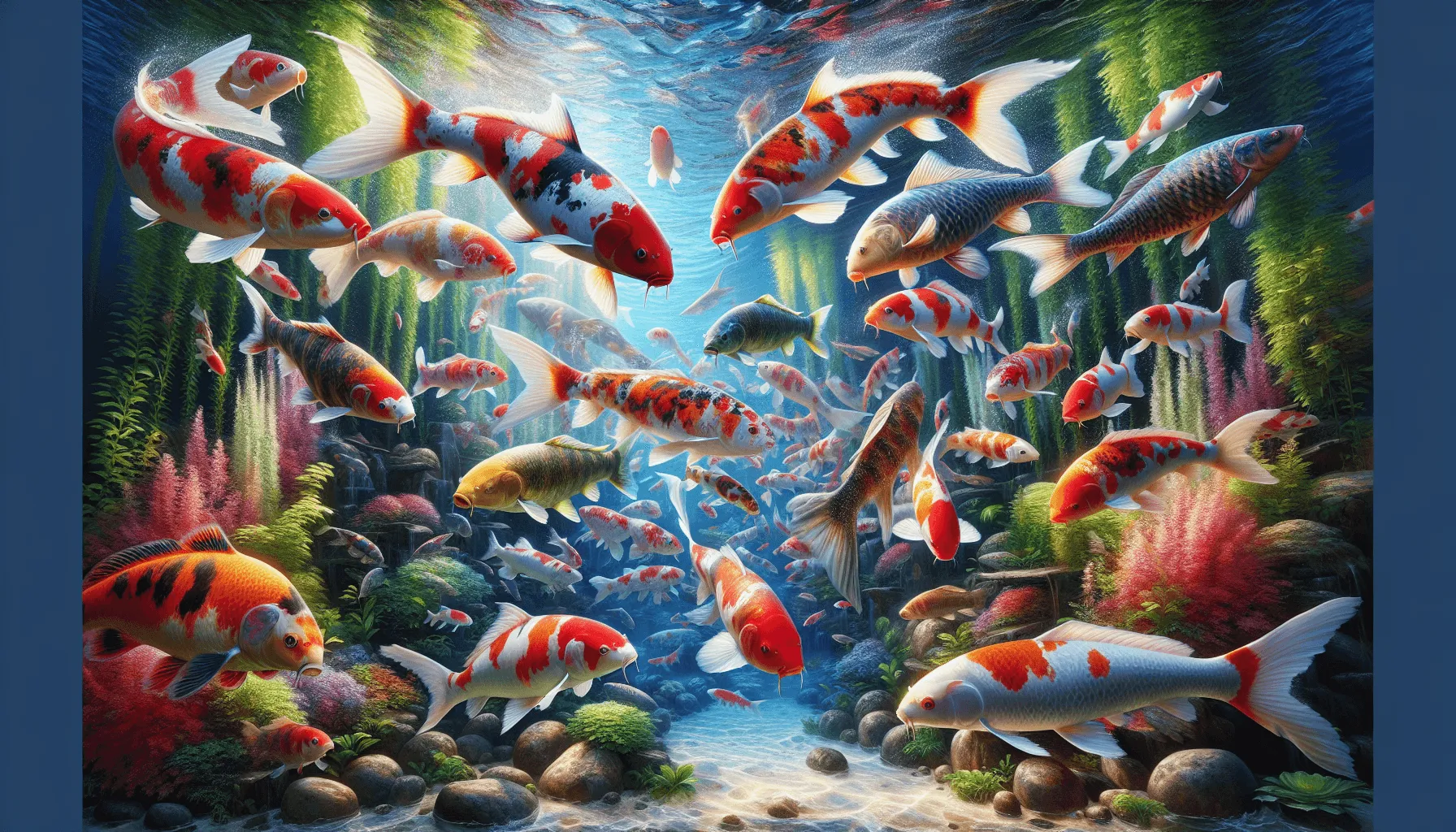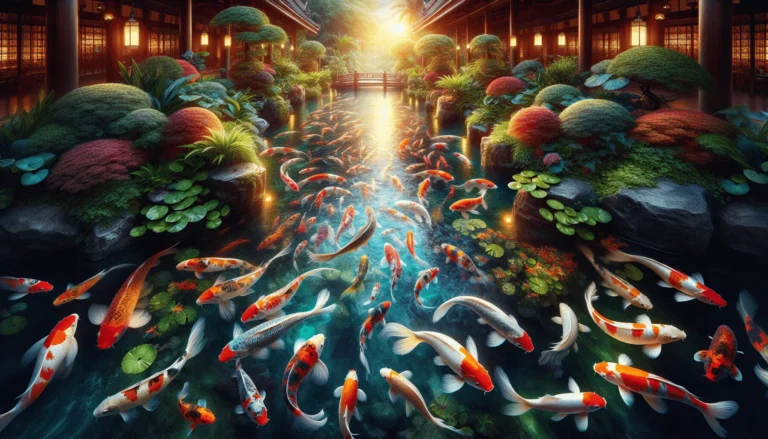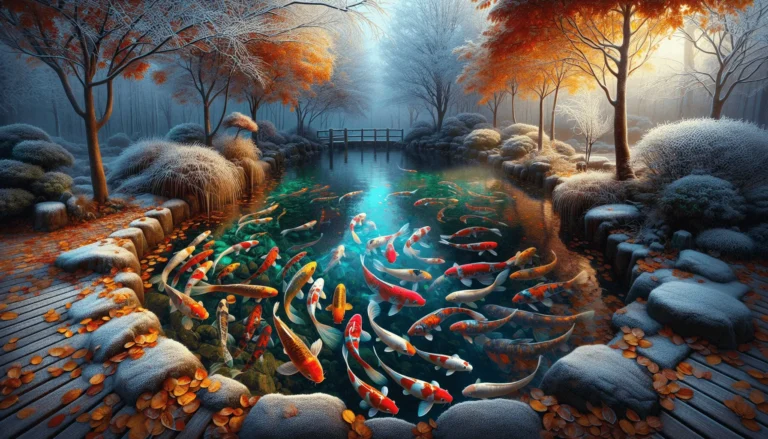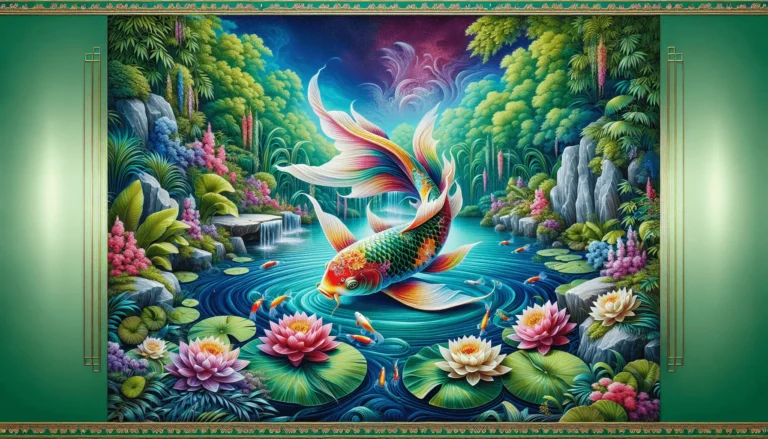Koi fish, known for their vibrant colors and graceful movements, originate from the murky ponds of Japan. These ornamental carp have captivated enthusiasts worldwide, leading to the question: can koi fish live in an aquarium?
Understanding the specific care requirements for koi is crucial for potential aquarium keepers. Koi thrive in spacious environments with stable water conditions, which can be challenging to replicate in a confined tank.
Key takeaway: While koi can live in aquariums, there are specific considerations to ensure their well-being. Proper planning and maintenance are essential to provide a healthy and suitable environment for these majestic fish.
Understanding Koi Fish
Koi fish, scientifically known as Cyprinus rubrofuscus, are a domesticated variety of the common carp. They are renowned for their vibrant colors and patterns, which make them a popular choice among aquarium and pond enthusiasts.
Species and Characteristics
Coloration
Koi come in various colors, including white, black, red, yellow, blue, and cream. Their distinctive patterns are often categorized into specific types such as Kohaku (red and white) or Sanke (white with red and black).
Body Structure
Koi have a robust body structure with barbels on each side of their upper jaw. These sensory organs help them locate food in murky water.
Size and Growth Rate
A common misconception is that koi fish will remain small if kept in a tank. In reality, koi can grow to impressive sizes:
- Typical Size: Adult koi typically reach lengths of 24 to 36 inches.
- Growth Rate: Koi grow rapidly, especially in their first few years. It’s not uncommon for young koi to outgrow an aquarium within 12 months.
Lifespan Expectations
When provided with appropriate living conditions, koi can live for several decades:
- Average Lifespan: Well-cared-for koi have an average lifespan of 25 to 35 years.
- Optimal Conditions: Ensuring clean water, balanced diet, and adequate space is crucial for maximizing their lifespan.
Understanding these characteristics is essential when considering whether koi fish can live in a fish tank long-term. Proper knowledge helps create an environment that supports their growth and health.
Moreover, it’s interesting to note that koi fish can also coexist with other species in a pond setting, such as goldfish. This highlights their versatility as both tank-dwelling and pond-dwelling creatures.
Can Koi Fish Thrive in an Aquarium?
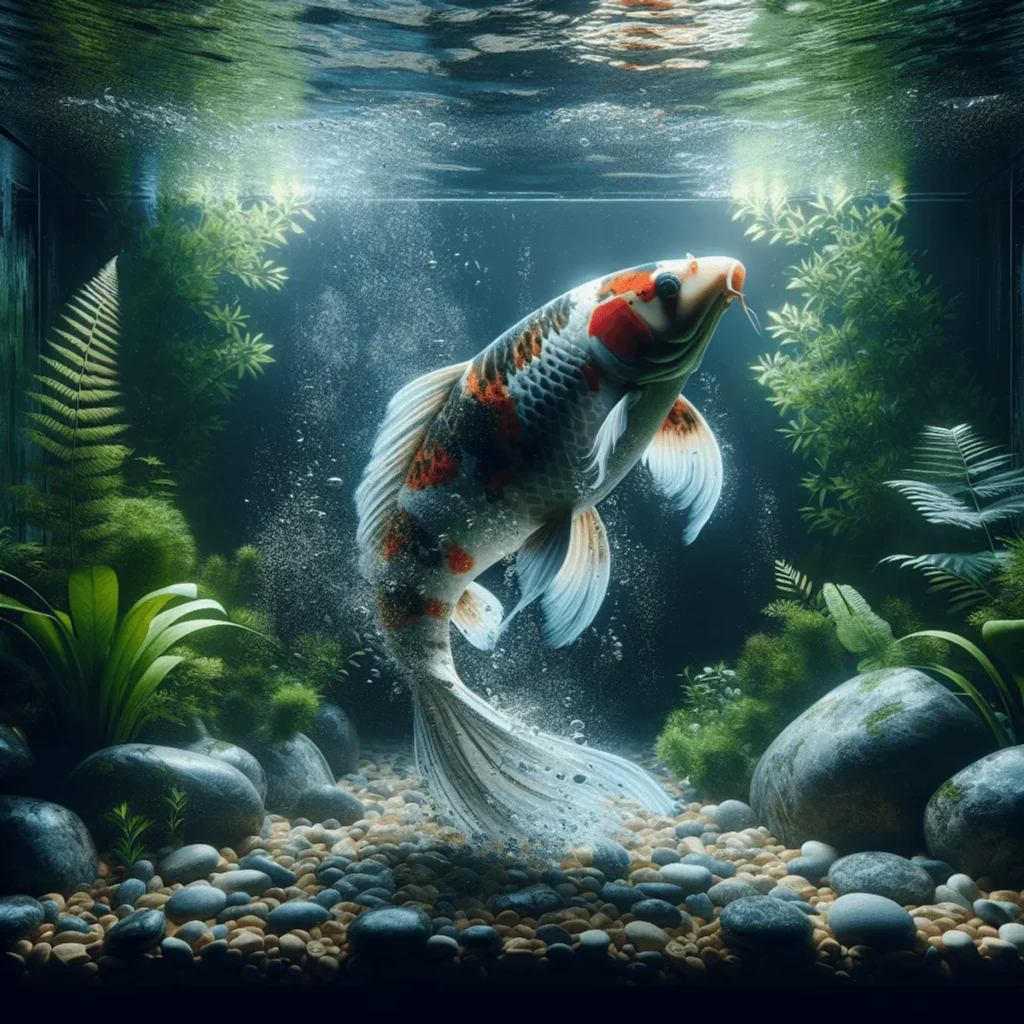
Koi fish are known for their vibrant colors and graceful movements, making them a popular choice for fish enthusiasts. The question is not just whether koi can survive in an aquarium but if they can truly thrive.
Ideal Environment for Koi
Creating an ideal environment for koi involves replicating the conditions they would experience in a pond. This means providing ample space, stable water conditions, and proper filtration. While koi can technically live in an aquarium, their long-term health and well-being depend largely on the quality of their environment. For instance, keeping koi in an undersized tank can lead to stunted growth and health issues, similar to what one might experience with goldfish, which also require adequate space to thrive.
Debunking Myths About Tank Suitability
Many believe that koi will stay small if kept in a small tank. This is a misconception. Koi have the potential to grow up to 24-36 inches regardless of tank size. Keeping them in an undersized tank can lead to stunted growth and health issues, much like the experiences shared by those who have kept koi in smaller tanks.
Short-Term vs Long-Term Housing Considerations
Short-Term Housing:
- Small koi can be kept in aquariums temporarily.
- This approach is feasible for about one year.
- During this period, it’s crucial to monitor their growth and adjust their living conditions accordingly.
Long-Term Housing:
- Long-term housing in an aquarium poses several risks.
- Potential problems include stunted growth due to limited space and poor water quality from inadequate filtration.
- Over time, these factors can lead to severe health issues, making it challenging for koi to thrive.
Potential Risks of Long-Term Aquarium Housing
Keeping koi in an aquarium long-term may result in:
- Stunted Growth: Limited space restricts natural development.
- Health Issues: Poor water quality and insufficient filtration can lead to diseases.
- Behavioral Problems: Confinement may affect the social behavior of these typically active fish.
Understanding these considerations helps ensure that your koi not only survive but also flourish, reflecting their natural beauty and vigor. However, it’s worth noting that certain tankmates such as axolotls or even some types of catfish could potentially cohabit with koi under specific circumstances. But careful thought must be given to compatibility and space requirements, as seen in situations involving catfish being housed with other species.
Tank Size Requirements for Koi Fish
When considering the aquarium size for koi, it’s crucial to understand their growth potential and space needs. Koi fish can reach lengths of 24-36 inches, requiring a substantial amount of space to thrive. A common recommendation is at least 1000 liters (approximately 264 gallons) for multiple koi. This allows them ample room to swim and reduces stress.
Practical Examples of Tank Sizes
- For young or small koi: A 75-gallon tank may suffice temporarily, but anticipate upgrading as they grow.
- Medium-sized koi: A 150-gallon tank can house a few medium-sized koi, though it’s best used as an intermediary before moving them to a larger environment.
- Large koi: Tanks of 300 gallons or more are necessary, ensuring enough space for their full-grown size.
Consequences of Overcrowding
Overcrowding in tanks poses significant risks:
- Water Quality Deterioration: High fish density increases waste production, overwhelming filtration systems and leading to poor water quality.
- Health Issues: Poor water conditions can cause health problems such as fin rot, parasites, and stunted growth.
- Behavioral Stress: Limited space can lead to aggressive behavior and stress among fish, impacting their overall well-being.
Maintaining appropriate tank sizes based on the expected growth of your koi helps mitigate these risks. Adequate space ensures better water quality and healthier fish, making it a vital consideration for any koi keeper.
Maintaining Water Quality and Filtration Needs in a Koi Aquarium
Stable water conditions are crucial for the health of koi fish. Ensuring the right balance of temperature, pH, and filtration can significantly impact your koi’s well-being.
Key Factors for Water Quality Maintenance
1. Temperature
Koi thrive in temperatures ranging from 70°F to 75°F. Sudden fluctuations can stress the fish, making them susceptible to diseases.
2. pH Levels
A stable pH between 7.0 and 8.5 is ideal. Regular testing helps maintain this balance and prevents harmful shifts.
3. Filtration Systems
Given their size, koi produce a substantial amount of waste. Efficient filtration systems are crucial to handle this load. Look for filters with high flow rates and multiple stages of filtration, including mechanical, biological, and chemical processes.
Effective Filtration Systems
Filtration systems suitable for aquariums housing koi need to be robust:
- Canister Filters: These external filters provide excellent mechanical and biological filtration, ideal for large tanks.
- Sump Filters: Often used in marine setups but equally effective for koi, sump filters offer additional water volume and superior filtration capabilities.
- UV Sterilizers: While not a replacement for regular filtration, UV sterilizers help control algae and pathogenic bacteria, contributing to overall water quality.
Feeding Your Pet Koi: A Balanced Diet Guide
Nutrition plays a critical role in maintaining healthy koi. A balanced diet supports growth, coloration, and vitality.
Dietary Needs
- Pellets: High-quality pellets should form the staple of your koi’s diet. Look for options rich in protein during growth phases and those with added vitamins during maintenance phases.
- Fresh Food: Supplementing with fresh foods like vegetables (peas, lettuce) or fruit (orange slices) enhances nutrition.
Feeding Schedule
Tailor feeding schedules based on life stages:
- Young Koi (Fry): Feed small amounts 3-4 times daily.
- Juvenile Koi: Reduce feeding frequency to 2-3 times daily as they grow.
- Adult Koi: Once or twice daily feeding is sufficient. Overfeeding can lead to poor water quality due to excess waste production.
Maintaining optimal water conditions coupled with a balanced diet ensures that your koi fish remain healthy and vibrant in an aquarium setting.
Choosing Compatible Tank Mates for Your Koi Fish
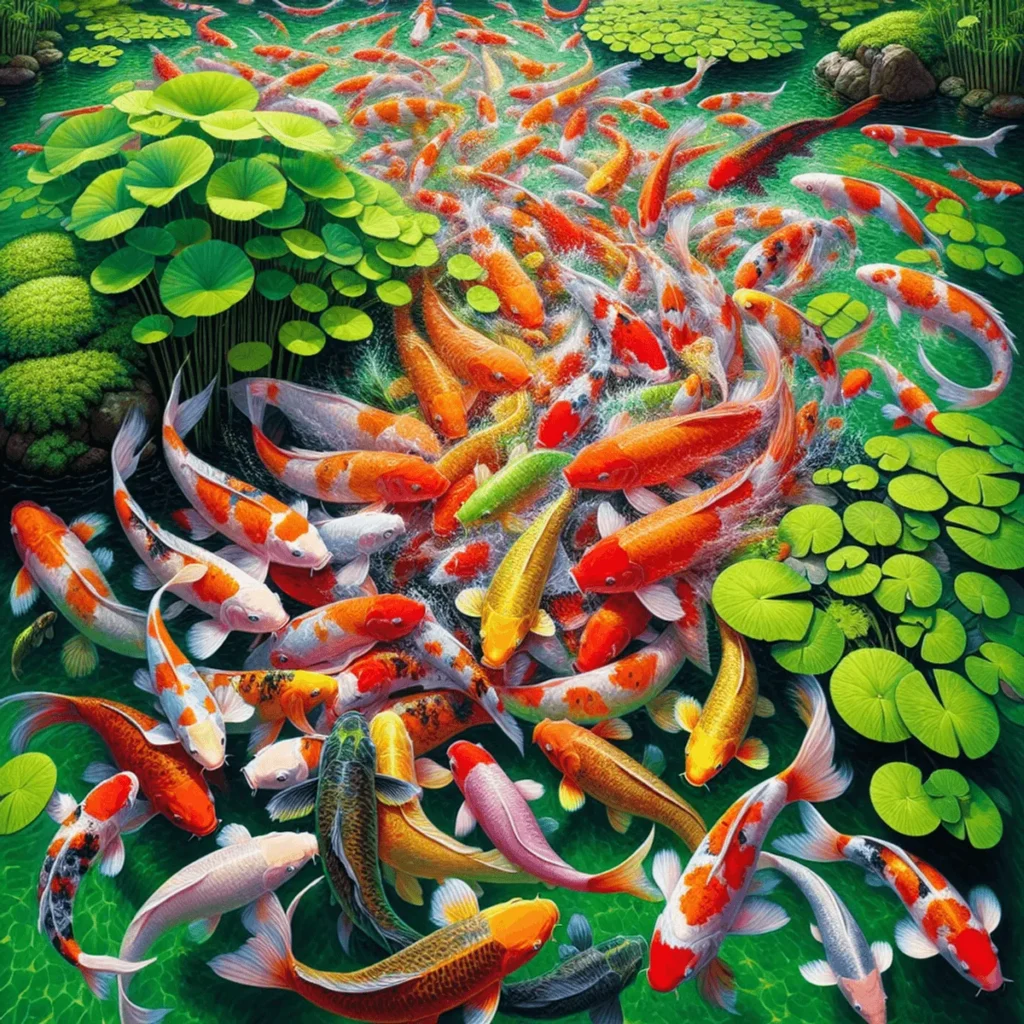
Understanding the Social Nature of Koi
Koi fish are naturally social creatures, often thriving in groups rather than being alone. This social behavior means you need to be careful when choosing tank mates to make sure everyone gets along.
Best tank mates for koi include:
- Plecos: Known for their peaceful nature and algae-eating habits, plecos can live with koi without fighting over food.
- Peaceful Cichlids: Some cichlid species that are calm and don’t compete with koi for food can be good friends.
- Goldfish: Since they need similar care, goldfish can be a great choice, as long as they’re big enough not to be seen as food.
When adding new fish, watch how they interact to avoid any potential fights or stress among the group.
Setting Up an Ideal Home Environment For Your Pet Kois
Creating a good living space for your koi involves more than just picking the right tank mates. The setup should meet their physical and social needs, ensuring a stable and healthy environment.
Key components needed in an aquarium setting:
- Filtration System:
- High Capacity Filters: Koi produce a lot of waste, so you’ll need efficient filters to keep the water clean.
- Mechanical and Biological Filtration: Both types are important to handle debris and convert harmful ammonia into less toxic substances.
- Aeration Systems:
- Air Pumps and Stones: Make sure there’s enough oxygen in the water, which is crucial for all aquatic life.
- Surface Agitation Devices: Help with gas exchange and maintain oxygen-rich water.
- Tank Layout Planning:
- Adequate Space: Plan for the growth of koi, avoiding overcrowding which can lead to stress and disease.
- Hiding Spots and Decorations: Provide areas where fish can retreat if feeling threatened, using plants or specially designed aquarium decor.
- Water Parameters Maintenance:
- Stable Temperature (Above 70°F): Use heaters if necessary to maintain consistent temperatures.
- Regular Water Changes: Prevents accumulation of toxins, supporting overall health.
By incorporating these elements into your aquarium setup, you’re creating a supportive environment where koi can thrive alongside their chosen companions. This approach not only addresses their immediate needs but also encourages long-term well-being.
Weighing The Pros And Cons Of Keeping Kois In Tanks Vs Ponds
Pros of Keeping Koi in Tanks:
- Easier Maintenance: Many hobbyists find that maintaining water quality and performing regular tank cleanings are more manageable in an indoor aquarium setting.
- Controlled Environment: Indoor tanks allow for better control over temperature and other environmental variables, protecting koi from extreme weather conditions.
- Accessibility: Observing and interacting with your koi is easier in a home aquarium. You can closely monitor their health and behavior.
Cons of Keeping Koi in Tanks:
- Space Limitations: Koi fish can grow up to 36 inches, requiring large tanks to accommodate their size. This often means significant space and financial investment.
- Rapid Growth: Koi can quickly outgrow standard aquariums, necessitating frequent upgrades or a transition to an outdoor pond.
- Health Risks: Limited space can lead to overcrowding, elevating stress levels and increasing the risk of disease.
Pros of Keeping Koi in Ponds:
- Natural Habitat: Outdoor ponds offer a more natural environment where koi can thrive, with ample space for swimming and growth.
- Aesthetic Appeal: A well-maintained pond can enhance the landscape of a garden or backyard, providing a tranquil spot for relaxation.
- Community Setting: Larger ponds support the social nature of koi, allowing them to live in groups without the constraints of a tank.
Cons of Keeping Koi in Ponds:
- Environmental Exposure: Ponds are subject to external elements such as predators, fluctuating temperatures, and debris, which require careful management.
- Complex Maintenance: Maintaining water quality in a pond can be more challenging due to larger volumes of water and the need for robust filtration systems.
- Seasonal Challenges: Outdoor ponds may require winterization or heating systems to keep koi healthy during colder months.
Personal experiences vary widely among hobbyists. Some prefer the controlled environment of aquariums, while others advocate for the spaciousness and natural setting provided by ponds. Both setups have unique benefits and challenges that cater to different preferences and resources.
For those leaning towards pond keeping, it’s essential to understand how to manage pH levels effectively for optimal koi health as detailed in this pH level guide. Additionally, it’s crucial to consider the nutritional aspects that influence koi growth when choosing between these two options.
Conclusion: Making an Informed Decision on Keeping Koi as Pets
Keeping healthy koi as pets requires significant commitment whether you choose a tank or pond setup. Both environments demand diligent care and attention to ensure the well-being of these vibrant fish.
- Commitment: Maintaining optimal water quality, proper diet, and suitable tank size or pond conditions necessitates continuous effort and investment.
- Research: Thoroughly understanding the needs of koi fish is crucial. Engage with expert advice, read extensively on the subject, and consider consulting experienced koi keepers.
Prioritize making informed decisions to provide a thriving environment for your koi fish.
FAQs (Frequently Asked Questions)
Can koi fish live in an aquarium?
Yes, koi fish can live in aquariums, but there are specific considerations to ensure their well-being. It’s important to understand their care requirements and provide an appropriate environment.
What size aquarium is recommended for koi fish?
Recommended tank sizes for koi fish vary based on their expected growth. Generally, a larger tank is better to prevent overcrowding, which can negatively impact water quality and fish health.
How long do koi fish typically live?
Koi fish can have a long lifespan when properly cared for, often living over 20 years. Providing appropriate living conditions is crucial for their longevity.
What are the ideal water conditions for koi in an aquarium?
Stable water conditions, including temperature and pH levels, are vital for koi health. Effective filtration systems are also necessary to manage their waste load efficiently.
Can koi fish be kept with other species in the same tank?
Yes, koi fish can be kept with compatible tank mates such as plecos or peaceful cichlids. It’s essential to choose species that won’t compete aggressively for resources.
What are the pros and cons of keeping koi in tanks versus ponds?
Keeping koi in tanks offers easier maintenance but has space limitations compared to ponds. Each setup has its advantages and disadvantages depending on the hobbyist’s preferences and experiences.

